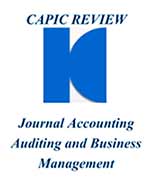Prediction of risk classifications of chilean companies with financial ratios, using discriminating analysis
Keywords
- Bonds of Chilean firms,
- Financial Ratios,
- Risk Classifications
How to Cite
Abstract
The risk classifications are very important as an element that reflects the risk related to the operations with the different companies considering this risk influences the returns that may be required by the investors, so the objective of this research is to select a set of financial ratios that allow to correctly predict about 70% of the risk classifications of Chilean companies; demonstrating at the same time, that it is possible to predict such classifications, by means of financial ratios. The analysis is developed using a sample of 18 and 17 companies, which issued corporate bonds in 2012 and 2013 respectively and applying the statistical technique of Discriminant Analysis with statistical software, Statgraphics Centurion XVI. The results show that when using the ratios of: working capital / total assets, current ratio, debt ratio, long-term debt / capital, return on assets, and EBITDA margin, it is possible to correctly predict 88.89% and 94, 12% of the risk classifications assigned to companies, for the periods under study. It is, therefore, possible to affirm that the use of financial ratios for the correct prediction of risk classifications is effective, based on the fact that these are based on public financial information, which is later complemented with other kind of information.
Downloads
References
2. Altman, E. I. (Julio de 2000). Predicting Financial Distress of Companies: Revisiting the Z-Score and ZETA® Models. Recuperado el 15 de Noviembre de 2014, de Recent Papers: Edward I. Altman: http://people.stern.nyu.edu/ealtman/papers.html
3. Altman, E. I. (Ed.). (Marzo de 2010). The Z-Metrics™ Methodology For Estimating Company Credit Ratings and Default Risk Probabilities. Recuperado el 8 de Noviembre de 2014, de Recent Papers: Edward I. Altman: http://people.stern.nyu.edu/ealtman/papers.html
4. Altman, E. I., & Sabato, G. (Noviembre de 2006). Modeling Credit Risk for SMEs: Evidence from the US Market. Recuperado el 15 de Noviembre de 2014, de Recent Papers: Edward I. Altman: http://people.stern.nyu.edu/ealtman/papers.html
5. Altman, E. I., Danovi, A., & Falini, A. (26 de Abril de 2013). Z-Score Models’ application to Italian companies subject to extraordinary administration. Forum, IV, 24-37.
6. Altman, E. I., Haldeman, R. G., & Narayanan, P. (1977). ZETA Analysis: A new model to identify bankruptcy risk of corporations. Journal of Banking and Finance, 29-54.
7. Altman, E. I., Iwanicz-Drozdowska, M., Laitinen, E. K., & Suvas, A. (9 de Julio de 2014). Distressed Firm and Bankruptcy Prediction in an International Context: A review Empirical Analyisis of Altman’s Z-Score Model. Recuperado el 16 de Noviembre de 2014, de Recent Papers: Edward I. Altman: http://people.stern.nyu.edu/ealtman/papers.html
8. Altman, E. I., Marco, G., & Varetto, F. (1994). Corporate Distress Diagnosis: Comparisons Using Linear Discriminant Analysis and Neural Networks (The Italian Experience). Journal of Banking and Finance, 18(3), 505-529.
9. Brealey, R. A., Myers, S. C., & Allen, F. (2010). Principios de Finanzas Corporativas (Novena ed.). (A. Deras Q., & M. Á. Tinoco Z., Trads.) D.F., México: McGraw-Hill.
10. Comisión Clasificadora de Riesgo. (s.f.). Comisión Clasificadora de Riesgo (CCR). Recuperado el 28 de Noviembre de 2014, de http://www.ccr.cl/index.php?idioma=espanol
11. Esperguel, J. A. (2004). Clasificación de Riesgo de Sociedades Anónimas Abiertas Chilenas Usando Ratios Financieros Procesados por Software Data Mining. Tesis de Magister, Universidad Austral de Chile, Escuela de Graduados, Valdivia.
12. Fitch Ratings. (2 de Diciembre de 2011). Proceso de Calificación. Recuperado el 9 de Noviembre de 2014, de Documentos: Fitch Ratings Chile: http://www.fitchratings.cl/Documentos/Forms/AllItems.aspx
13. Foster, G. (1986). Financial Statement Analysis. United States of America: Prentice-Hall International Editions.
14. González L., Á. M. (2013). Estadística aplicada al Turismo utilizando SPSS y STATGRAPHICS Plus. Guayaquil, Ecuador: Centro de Publicaciones - Universidad ECOTEC.
15. Guzmán A., M. T. (2010). Análisis de Riesgo de Crédito y Evidencia Empírica en Chile. Universidad de Chile, Escuela de Economía y Administración, Santiago.
16. Lev, B. (1978). Análisis de Estados Financieros: Un Nuevo Enfoque. (P. Castañeda Ordoñez, Trad.) Madrid: Ediciones Esic.
17. Martín M., M. Á. (2007). Inversiones: Instrumentos de renta fija, valoración de bonos y análisis de cartera (Primera ed.). México: Pearson Prentice Hall.
18. Ministerio de Hacienda. (10 de Octubre de 2014). Ley de Mercado de Valores. Chile.
19. Ministerio de Hacienda. (s.f.). Glosario: Ministerio de Hacienda. Recuperado el 9 de Noviembre de 2014, de http://www.hacienda.cl/glosario/ clasificacion-de-riesgo.html
20. Ortega G., J., Martinez G., J., & Valencia B., J. C. (2010). El Modelo de Calificación Crediticia ZScore: Aplicación en la Evaluación del Riesgo Crediticio de HB Fuller Colombia Ltda. Revista MBA EAFIT, 102-111.
21. Superintendencia de Valores y Seguros. (22 de Junio de 2012). SVS Informa Sanciones a Clasificadoras de Riesgo de Empresas La Polar S.A. Superintendencia de Valores y Seguros.
22. Superintendencia de Valores y Seguros. (s.f.). Mercado de Valores: Clasificadoras de Riesgo. Recuperado el 22 de Noviembre de 2014, de http://www.svs.cl/portal/principal/605/w3-propertyvalue-18542.html
23. Superintendencia de Valores y Seguros. (s.f.). SVS Educa: Portal de Educación Financiera. Recuperado el 25 de Noviembre de 2014, de http://www.svs.cl/educa/600/w3-propertyvalue-557.html
24. Vivanco, M. (1999). Análisis Estadístico Multivariable: Teoría y Práctica (Primera ed.). Santiago, Chile: Editorial Universitaria.
25. Weston, J. F., & Brigham, E. F. (1987). Finanzas en Administración (Séptima ed., Vol. I). (J. Gómez Mont, Trad.) México: Interamericana, S.A.


































